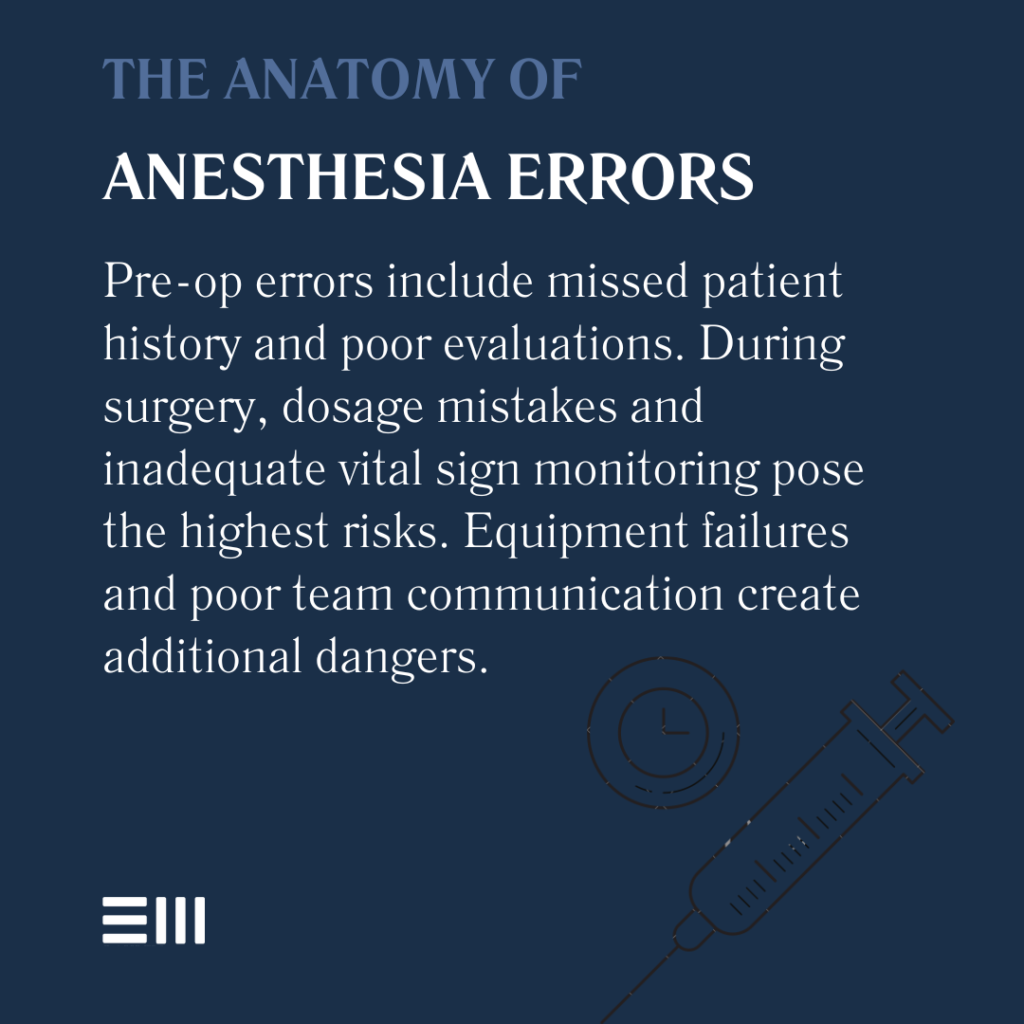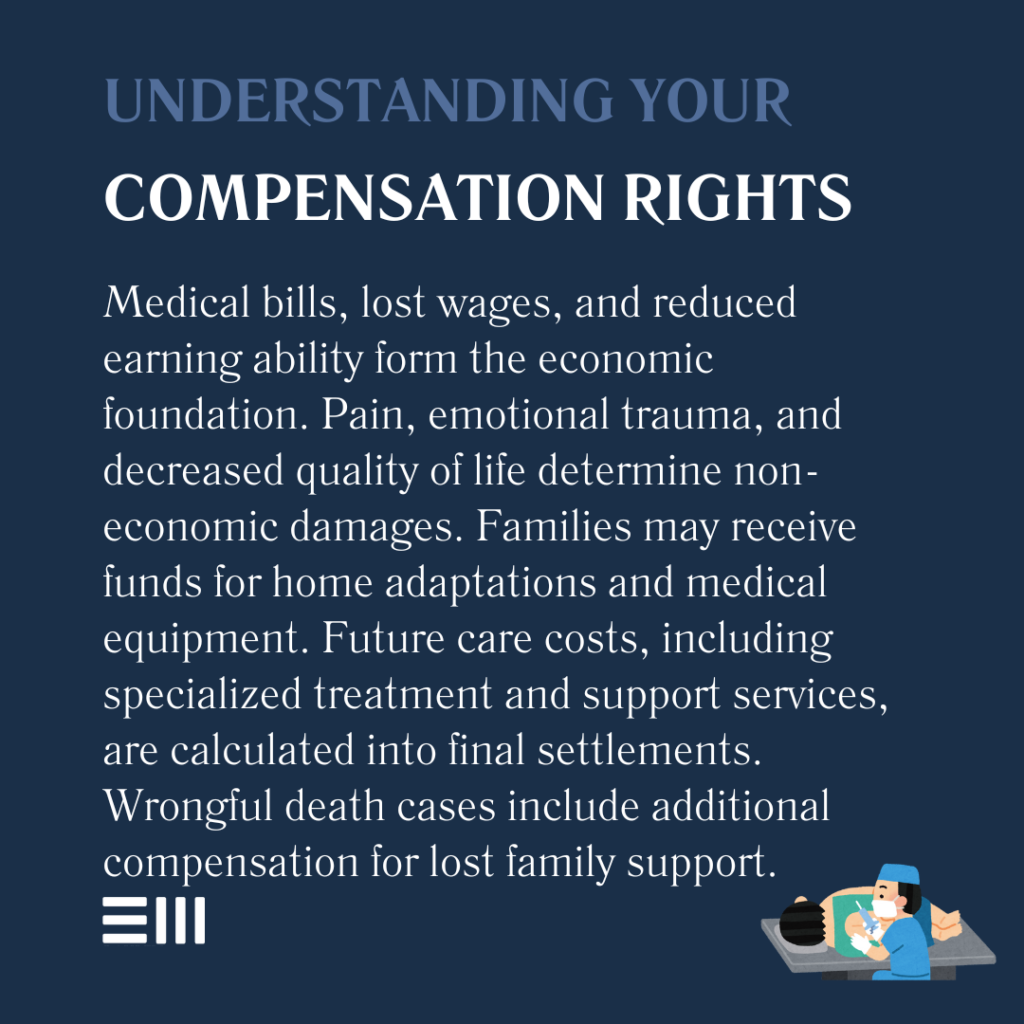
The estimated rate of anesthesia-related deaths stands at 1.1 per million population annually, with males experiencing nearly twice the risk at 1.45 deaths compared to 0.77 for females.
While these numbers might appear small, they represent preventable tragedies that devastate families and raise serious questions about medical care standards.
Behind each statistic lies a story of trust placed in medical professionals and the life-altering consequences when that trust is broken through medical negligence or error.
Understanding Anesthesia Errors and Medical Malpractice
Anesthesia administration represents one of the most complex and high-risk aspects of medical care, requiring precise calculations, careful monitoring, and expert judgment.
When healthcare providers deviate from established standards of care, the consequences can be devastating, leading to life-altering injuries or death.
Understanding these errors is crucial for both prevention and seeking appropriate legal remedies when negligence occurs.
The following list encompasses the most common types of anesthesia errors that occur in medical settings:
Types of Anesthesia Errors:
- Dosage errors (administering too much or too little anesthesia);
- Failure to monitor vital signs during procedures;
- Delayed anesthesia delivery;
- Failure to recognize and respond to complications;
- Improper intubation techniques;
- Adverse drug interactions;
- Equipment malfunction or misuse;
- Poor communication between medical team members;
- Failure to review patient medical history;
- Inadequate pre-operative patient evaluation;
- Failure to account for patient allergies;
- Improper positioning during surgery;
- Inadequate oxygen delivery;
- Faulty equipment maintenance; and
- Documentation errors.
These errors can occur at any stage of the anesthesia process, from pre-operative evaluation to post-operative recovery, highlighting the need for constant vigilance and proper protocols.
When anesthesia errors occur, patients may experience a range of adverse reactions and complications that can have both immediate and long-term impacts on their health:
- Brain damage from oxygen deprivation;
- Cardiovascular complications;
- Nerve damage;
- Spinal cord injury;
- Malignant hyperthermia;
- Awareness during surgery;
- Allergic reactions;
- Post-operative confusion or memory loss;
- Respiratory problems;
- Death in severe cases;
- Chronic pain syndromes;
- Seizures;
- Visual impairment;
- Cognitive dysfunction;
- Emotional trauma;
- Blood pressure complications;
- Organ failure;
- Tracheal damage;
- Paralysis; and
- Birth defects (in cases involving pregnant patients).
These complications can lead to lifelong disabilities and significant medical expenses, fundamentally altering a patient’s quality of life.

Factors Contributing to Anesthesia Errors
Multiple factors can contribute to anesthesia errors, often working in combination to create dangerous situations for patients.
Understanding these factors helps identify potential risks and prevent future incidents:
- Inadequate staffing levels;
- Fatigue among medical personnel;
- Poor communication protocols;
- Rushed pre-operative assessments;
- Inadequate training or supervision;
- Outdated equipment;
- Complex medical histories;
- Emergency situations;
- Language barriers;
- Time pressures;
- Budget constraints affecting safety measures;
- Lack of standardized procedures;
- Poor record-keeping systems;
- High-stress medical environments; and
- Multiple surgical teams working simultaneously.
These risk factors highlight the complex nature of anesthesia administration and the importance of comprehensive safety protocols.
Proving Medical Malpractice in Anesthesia Error Cases
Building a successful medical malpractice case requires demonstrating that the healthcare provider failed to meet the accepted standard of care and that this failure directly caused harm.
A qualified medical malpractice attorney can help gather evidence, consult medical experts, and establish the critical elements of negligence.
To prove medical malpractice in anesthesia error cases, several key elements must be established:
- Existence of doctor-patient relationship;
- Violation of standard of care;
- Direct causation between error and injury;
- Documented damages and losses;
- Expert testimony supporting the claim;
- Evidence of proper safety protocols being ignored;
- Documentation of pre-existing conditions;
- Proof of informed consent issues;
- Evidence of equipment maintenance records;
- Communication breakdowns in medical records;
- Timeline of events leading to injury;
- Documentation of staff qualifications;
- Evidence of protocol violations;
- Witness statements; and
- Hospital policies and procedures.
Successfully proving these elements requires extensive documentation and expert testimony.
Legal Rights and Compensation
When patients suffer harm from anesthesia errors, they have specific legal rights under Alabama law.
Understanding these rights is essential for making informed decisions about pursuing legal action and securing appropriate compensation for damages.
The following types of compensation may be available to victims of anesthesia errors:
- Medical expenses (past and future);
- Lost wages and earning capacity;
- Pain and suffering;
- Emotional distress;
- Rehabilitation costs;
- Home care expenses;
- Loss of quality of life;
- Permanent disability costs;
- Family impact compensation;
- Wrongful death damages when applicable;
- Future medical treatment needs;
- Specialized medical equipment;
- Home modifications;
- Transportation costs;
- Mental health treatment;
- Loss of consortium;
- Occupational therapy expenses;
- Diminished earning potential;
- Cost of in-home care; and
- Loss of enjoyment of life.
These damages aim to provide comprehensive compensation for both economic and non-economic losses suffered by victims and their families.

Prevention and Patient Safety Measures
Healthcare facilities must implement robust safety protocols to prevent anesthesia errors. Understanding these measures helps patients advocate for their safety and identify potential red flags.
Here are essential safety practices that should be in place:
- Comprehensive pre-operative screening;
- Clear communication of medical history;
- Verification of medication allergies;
- Modern monitoring equipment usage;
- Regular staff training updates;
- Emergency response protocols;
- Patient education programs;
- Quality assurance reviews;
- Documentation improvements;
- Team-based safety approaches;
- Regular equipment maintenance;
- Standardized handoff procedures;
- Clear chain of command;
- Continuous vital sign monitoring;
- Regular safety audits;
- Staff certification verification;
- Emergency equipment checks;
- Patient identification protocols;
- Drug inventory management; and
- Communication protocols.
Implementation of these safety measures significantly reduces the risk of anesthesia-related complications and improves patient outcomes.
The Role of Medical Experts
Medical experts play a crucial role in anesthesia error cases, providing essential testimony and analysis.
Their expertise helps establish:
- Standard of care analysis;
- Causation determination;
- Injury assessment;
- Treatment recommendations;
- Future care needs evaluation;
- Protocol review;
- Equipment analysis;
- Medical record review;
- Cost projections;
- Risk assessment;
- Alternative treatment options;
- Industry-standard practices;
- Training adequacy assessment;
- Safety protocol evaluation; and
- Long-term prognosis determination.
Expert testimony forms the foundation of successful medical malpractice claims.
Frequently Asked Questions About Anesthesia Error Cases in Alabama
Understanding the complexities of anesthesia error cases helps patients navigate their legal options. Here are common questions patients often ask when considering legal action.
How Long Do I Have to File an Anesthesia Error Claim?
In Alabama, medical malpractice claims must typically be filed within two years of the incident. However, exceptions exist when injuries are discovered later.
What Evidence is Needed to Support My Case?
Medical records, expert testimony, witness statements, and documentation of damages form the foundation of a strong anesthesia error case.
How Are Anesthesia Error Cases Different From Other Medical Malpractice Claims?
Anesthesia cases often involve complex medical evidence, multiple responsible parties, and severe consequences requiring specialized legal expertise.
What Compensation Can I Recover?
Awards may include medical costs, lost income, pain and suffering, and long-term care expenses, depending on injury severity and impact.
How Long Does an Anesthesia Error Case Usually Take?
While each case varies, most medical malpractice claims take 1-3 years to resolve through settlement or trial.
Take Action: Protect Your Rights and Future
Don’t face the aftermath of an anesthesia error alone.
Our experienced medical malpractice attorneys understand the complexities of these cases and are ready to help you secure the compensation you deserve.
Contact us today for a confidential consultation to discuss your case and explore your legal options.
Can't find what you're looking for? Search our site below.










